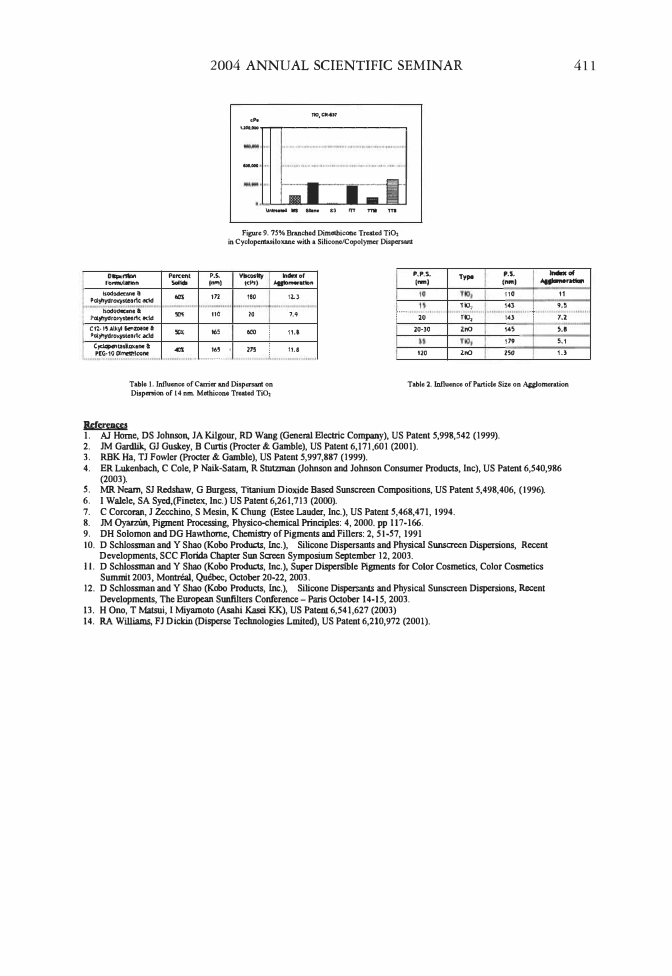2004 ANNUAL SCIENTIFIC SEMINAR 411 .,,. T10 1 CM:.U7 , ...............--.------------, toe,OOG ·•• UntnatldMI SllaM 2� m TT1I TTI Figure 9. 75% Branched Dimethicone Treated TiO, in Cyclopentasiloxane with a Silicone/Copolymer Dispersant Dispersion Percent P.S. VIKoslly lndonlof P.P.S, (NII) Type P,S, lndaof ro-.ilat1C1 §ol .. ,....., tl'l) Aglo,_,_n -1 ,...._......, tsodoc1«""" a 60% 1n 180 P0l)'hyllr�1•UN1tlc acid lod1dcane a 110' 10 i'allflYlrOrytle!lr1t e.id C 11-" Alkyl &enZOf� 8- � 165 600 : �olyt,ydroxvste•rk acid C�talll onc& -4CS 16! 275 j r£G· 10 OlrrctlliCOM ............... \�3 7.9 1U !1.8 I (·--· 20 2Q·30 120 no, rte, lnO lnO 110 11 143 9.5 !43 ·t 7.2 145 �-11 !79 5.1 250 1.) Table I. Influence of Carrier and Dispersant on Dispenion of 14 run. Methicone Treated TiO, Table 2. Influence of Particle Size on Agglomeration Refereiu;es 1. Al Home, DS Johnson, JA Kilgour, RD Wang (General Electtic Company), US Patent 5,998,542 (1999). 2. JM Gardlik, GJ Guskey, B Curtis (Procter & Gamble), US Patent 6,171,601 (2001). 3. RBK Ha, TJ Fowler (Procter & Gamble), US Patent 5,997,887 (1999). 4. ER Lukenbach, C Cole, P Naik-Satam, R Stutzman (Johnson and Johnson Consumer Products, Inc), US Patent 6,540,986 (2003). 5. MR Neam, SJ Redshaw, G Burgess, Titanimn Dioxide Based Sunscreen Compositions, US Patent 5,498,406, (1996). 6. I Walele, SA Syed,(Finetex, Inc.) US Patent 6,261,713 (2000). 7. C Corcoran, J Zecchino, S Mesin, K Chung (Estee Lauder, Inc.), US Patent 5,468,471, 1994. 8. JM Oyarzun, Pigment Processing, Physico-chemicalPrinciples: 4, 2000. pp 117-166. 9. DH Solomon and DG Hawthorne, Chemistry of Pigments and Fillers: 2, 51-57, 1991 10. D Schlossman and Y Shao (Kobo Products, Inc.), Silicone Dispersants and Physical Sunscreen Dispersions, Recent Developments, SCC Florida Chapter Sun Screen Symposium September 12, 2003. 11. D Schlossman and Y Shao (Kobo Products, Inc.), Super Dispersible Pigments for Color Cosmetics, Color Cosmetics Summit 2003, Montreal, Quebec, October 20-22, 2003. 12. D Schlossman and Y Shao (Kobo Products, Inc.), Silicone Dispersants and Physical Sunscreen Dispersions, Recent Developments, The European Sunfilters Conference -Paris October 14-15, 2003. 13. H Ono, T Matsui, I Miyamoto (Asahi Kasei KK), US Patent 6,541,627 (2003) 14. RA Williams, FJ Dickin (Disperse Technologies Lmited), US Patent 6,210,972 (2001).
412 JOURNAL OF COSMETIC SCIENCE A FAMILY OF EMOLLIENT ESTERS EXHIBITS ANTI-MICROBIAL PROPERTIES OF PRACTICAL USE TO FORMULATORS SEEKING TO REDUCE OR ELIMINATE THE USE OF PRESERVATIVES Introduction Monna Manning and Philip Orawski Abitec Corporation, Columbus, OH Kabara and others found that certain fatty acids and esters were useful as antimicrobial agents. 1• 2· 3 Based upon these findings, high purity monoesters of glycerin or propylene glycol were synthesized and assayed for their efficacy against traditional preservatives. Three emollient esters were selected for their anti-microbial properties. This range of high purity short-chain monoglyceride esters have been shown to offer performance comparable to "conventional" anti microbial agents or preservatives, without the need to register as preservatives. Experimental MIC Test and selection of three monoglycerides Eleven (11) structures were evaluated in a Minimum Inhibitory Concentration test (USP 61 "Microbial Limit Tests"), which tests the efficacy of antimicrobial agents versus concentration. Based upon performance in this test, three structures were chosen to pursue as commercially viable products. In all, eleven (11) organisms were used in MIC testing. The following tables indicate the results for four (4) of the most common organisms: Candida albicans ( a yeast), Aspergillus niger (a mold), Staphylococcus aureus (a gram positive bacterium), and Eschirichia. coli (a gram negative bacterium). The legend is"+" to indicate growth, and"-" to indicate microbiological kill. % Dilution 0.010 0.025 0.050 0.075 0.100 0.175 0.250 0.500 0.750 1.000 Candida albicans Propylene Glycol Heptanoat + + + Propylene Glycol Heptanoat + + Glyceryl Caprylate + + + Aspergillus niger Propylene Glycol Heptanoat + + Propylene Glycol Heptanoat + Glyceryl Caprylate + + + + + Staphylococcus aureus Propylene Glycol Heptanoat + + + + + Propylene Glycol Heptanoat + + + Glyceryl Caprylate + + + Escherichia coli Propylene Glycol Heptanoat + + + + + Propylene Glycol Heptanoat + + + + + + + + + + Glyceryl Caprylate + + + + + + + Challenge Test comparison to DMDM Hydantoin and parabens
Purchased for the exclusive use of nofirst nolast (unknown) From: SCC Media Library & Resource Center (library.scconline.org)






































































































